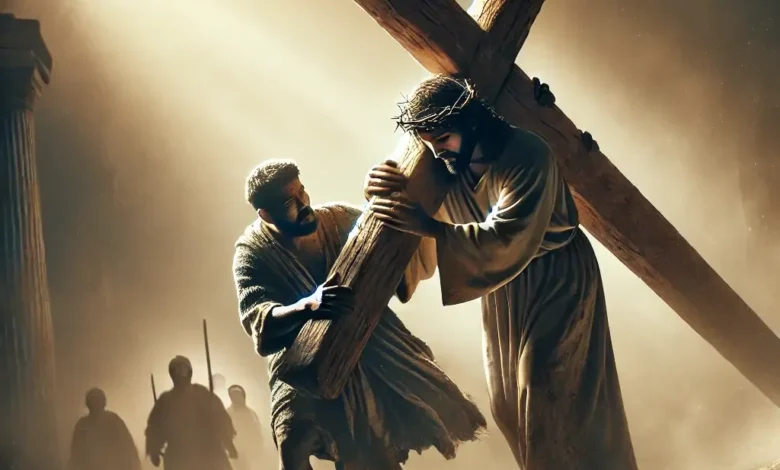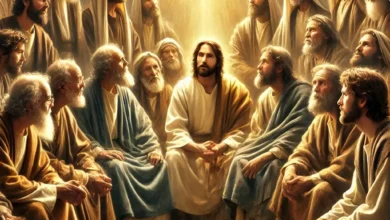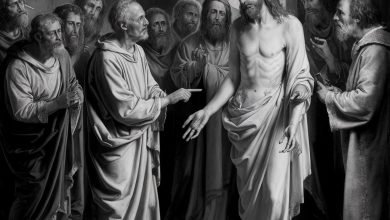
Why Did Jesus Need Help Carrying His Cross?
On the way to the crucifixion, the soldiers encountered a man named Simeon of Kirwani and forced him to carry Jesus’ cross all the way to Golgotha, or “the place of the skull,” where Jesus was brutally executed in a public execution. The cross was nailed.
Each account is slightly different—one names Shimon’s sons, the other tells us that Shimon was entering the city from the countryside—but the basics of the story are the same. Who is Shimon? Why did Jesus need help carrying his cross? And what is the deeper significance of this aspect of carrying the cross in the crucifixion?
فرست محتوا
What does the Bible say about Jesus carrying the cross?
The story of this event is found in the Gospels of Matthew, Mark and Luke, which are known as the Gospels.
Matthew’s version is the shortest and simply tells the readers, “As they went out, they met a man from Cyrene named Simon, and they forced him to carry the cross” (Matthew 27:32).
The narrative of the Gospel of Mark points out: “And Simon the Cyrene, the father of Alexander and Rufus, coming from the desert, was passing by, and they forced him to carry the cross. They brought Jesus to a place called Golgotha (which means “place of the skull”)” (Mark 15:21-22).
And Luke’s narration says: “When the soldiers were taking him away, they caught Simon of Cyrene, who was coming from the desert, and they put the cross on him and made him carry it behind Jesus’ head.” A large crowd of people followed him, including women who were weeping for him” (Luke 23:26-27).
Only the Gospel of John does not mention Simon of Cyrene, but says that Jesus carried his cross (John 19:17).

Who is Shimoun Qairvani?
The Bible doesn’t tell us much about this man, but we do know that Cyrene was a coastal city in North Africa east of Libya. Given that Alexander and Rufus, the sons of Simon, are mentioned in Mark’s text, they were clearly known to the readers of that writing.
Later in Romans 16:13 a person named “Rufus” is mentioned and it is mentioned that his mother was the same as the mother of the author of that book, although we do not know if this is the same Rufus or not. Also, the bones of “Alexander, son of Simon” from the same time period have recently been discovered in a burial container or crypt in Jerusalem.
Some believe that the mention of sons indicates that they later became followers of Christ and were active in the early church, perhaps because of their father’s role in carrying the cross.
But why this man? Why Shimon? The Bible only tells us that he was “taken” and “forced” to carry the cross.
Some believe that he may have been a Jew who had resettled in Cyrene and was now visiting Jerusalem, chosen by the soldiers for his Jewish appearance.
Others think that he was a black person who came to Jerusalem to worship at Passover. His race, ethnicity or religion is not known from these texts.
Why did Jesus need help to carry the cross?
The Bible doesn’t tell us if Jesus really needed help, only that the soldiers forced Simon to help him. But scientists believe that given the torture that Jesus endured, he was not physically fit to carry such a heavy object for such a long distance, at least from a human perspective.
Historians say that convicts were often forced to carry the crossbeam of their cross, which weighed between 30 and 40 pounds (about 13 and 18 kilograms).
The Bible tells us that before Jesus walked the Via Dolorosa (Way of Pain)—a winding path through several streets of Jerusalem to Calvary—he was punched, scourged, and crowned with thorns. And they hit his head many times with a staff (Mark 14:65; Mark 15:15, 19; Matthew 26:67; Matthew 27:29).
It would have been difficult for even most men to walk in such a state, let alone carry a cross on freshly scarred skin.
But it is clear that Jesus is more than just a man—as the Son of God, he is part of the Holy Trinity, the triune, three-in-one, co-eternal God.
This is why many scholars believe that Jesus “needed” help because of his own weakness, but for other reasons. In this dark moment, someone had to serve as a walking icon, a true bearer of the cross.
What are the symbols that Shimoun Qairvani carries?
First, Simeon is from Cyrene, meaning he is a foreigner. Whether he is Jewish or not, he is from somewhere other than this region, and thus his presence brings the “other” to the stage. Soon after the establishment of the Church, the Holy Spirit made the apostles understand that their message was not just for Israel, but for all people—Jews, Gentiles, and beyond.
Second, Simeon presents us with a model of discipleship. Jesus told his disciples in Luke 9:23-24: “Whoever wants to be my disciple must deny himself and take up his cross daily and follow me. For whoever wants to save his life will lose it, but whoever loses his life for my sake will keep it.
Here, we see a person literally carrying a cross and literally walking behind Jesus to the place of crucifixion. This is a beautiful picture of discipleship.
However, following Jesus is not always easy, especially if you live in a place or time where Christians are persecuted or the faith is punished with the death penalty.
Also, it is not always easy to go against the popular culture that favors the “law of retribution” or “doing whatever feels right”. But Jesus died for us. Therefore, we bear the cross for Him and share the gospel because He told us to.
Thirdly, the placement of these two men is significant and also indicates discipleship. The Bible tells us that Simon of Cyrene carried the cross behind Christ (Luke 23:26). We too must walk through life, sometimes in very difficult circumstances, keeping our Lord and Savior Jesus Christ before us as our example and leader, as we carry our cross.
And fourth, the act of carrying the cross was imposed on Shimon Kirwani and symbolized another important truth: carrying our cross is not necessarily a choice. Simon certainly could have said no—and probably would have been executed right there in the streets with Jesus.
Today in the article : what does the story of Jacob’s ladder mean in the Bible? We reviewed useful information about the Bible and the way of Jesus. If you wish, you can view other articles of Ali Vahidi about Christianity





